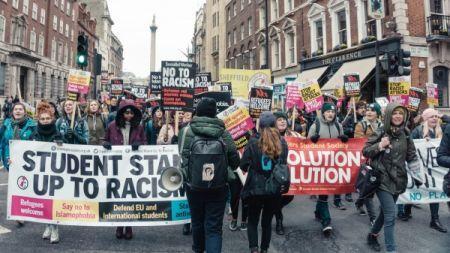On 12 February 2018, the Federal Court denied the University Malaya disciplinary board (UM)’s leave to appeal against the judicial review application of Fahmi Zainol and four other students (UM5). UM5 filed an application for judicial review against the disciplinary action taken against them for organising the ‘Pidato Umum: 40 Tahun dari Universiti Malaya ke Penjara’ event featuring Anwar Ibrahim as the main speaker in 2014. The judicial review application was allowed by the High Court in Shah Alam and unanimously upheld by the Court of Appeal. Details of the High Court’s decision can be found in the first part of this entry.
In absence of judgments by the Federal Court and Court of Appeal, this article explores some key concepts underlying the judicial review application and submissions in this case, including natural justice and the interplay between procedural fairness and substantive justice.
The Leave Application and the Appeal
In the Court of Appeal
Counsel for UM5 provided two main reasons against the UM’s appeal:
- There was procedural impropriety by the UM because of
- non-compliance with Rules 53 & 54 of the University of Malaya (Discipline of Students) Rules 1999 (“the 1999 Rules”);
- the rushed nature of the disciplinary proceedings – which were concluded within 13 hours despite involving 17 disciplinary charges against five students in the absence legal representation; and
- a secret meeting that was held between the UM and the appellate committee (established to hear and decide on appeals against the UM’s decisions)
resulting in a breach of natural justice.
- UM was unreasonable/irrational in failing to address its mind as to the standard of proof required – whether beyond reasonable doubt or on the balance or probability – since a decision-maker must take relevant considerations into account (Syarikat Kenderaan Melayu Kelantan Bhd v Transport Workers’ Union [1995] 2 MLJ 317 at p.342).
The appeal was dismissed with costs set at RM2,000. Chairing the panel was Justice David Wong Dak Wah, who held that there was no appealable error made by the High Court judge.1
In the Federal Court
UM applied for leave to appeal on five questions of law, namely:
- Whether the burden of proof in disciplinary action cases is proof of the charges beyond reasonable doubt or on a balance of probability;
- Where statute prescribes steps to be taken in a disciplinary hearing, whether the requirement of natural justice is complied with where there is general compliance (as opposed to sequential compliance) of the statute bearing in mind that disciplinary proceedings are inquisitorial in nature;
- Where it is shown that an application for judicial review is premised upon factual inaccuracies and/or untruths going to the root of the application, whether such inaccuracies and/or untruths are sufficient for the judicial review application to be dismissed in limine;
- Whether failure to raise non-compliance of procedure during the disciplinary hearing amounts to waiver which will prohibit an applicant from raising such new compliance during the hearing of the Judicial Review; and
- Where statute prescribes a particular authority to appoint a disciplinary authority, whether it is implicit that all other powers given to the appointing authority in the statute is mutatis mutandis, also vested in and/or transmitted to the disciplinary authority for the purposes of the domestic inquiry.
Counsel for UM5 submitted that leave should be denied because:
- Questions 2 and 5 of the appeal raised issues of law which had not been raised before the lower courts;
- Questions 1 and 3 were ‘abstract, academic or hypothetical’ and of no interest to the respondents (based on the Federal Court decision in Terengganu Forest Products Sdn Bhd v Cosco Container Lines Co Ltd & Anor and other applications [2011] 1 MLJ 25); and
- Question 4 did not satisfy the conditions of Section 96 of the Courts of Judicature Act 1964 (“the 1964 Act”) since the question on appeal was not novel or of public importance
The three-man bench of the Federal Court led by Raus Sharif CJ (as His Lordship then was) dismissed the application for leave to appeal, on the ground that UM had failed to cross the threshold required by s.96 of the 1964 Act.2
Natural Justice: The Case for Procedural Fairness
In light of the emphasis placed on procedural propriety in submissions before the Court of Appeal, this section examines the equivalence of natural justice to procedural fairness. While it acknowledges the traditional dichotomy between procedural fairness and substantive justice, this section asserts that fairness in process plays a significant part in achieving substantive justice; the procedural reinforces the substantive by giving it legitimacy.
The roots of procedural fairness are found in natural law, described by Cicero as “the law which was never written and which we were never taught, which we never learned by reading, but which was drawn from nature herself, in which we have never been instructed, but for which we were made, which was never created by man’s institutions, but which is inborn in us.” The concept of natural justice thus captures the idea that there is some instinct, inherent in the nature of humanity itself, that intuitively recognises what is fair and what is not. At its most basic level, therefore, the legal doctrine of natural justice is “no more than the duty to act fairly”.3
But this seems to beg the question: what exactly are the elements of ‘acting fairly’? In other words, what is required for one to be able to say with confidence that one has ‘acted fairly’?
Audi alteram partem
A fundamental rule of natural justice is the principle of audi alteram partem: let the other side be heard as well.
Rules 53 & 54 of the 1999 Rules states:
- (1) If the student pleads that he is not guilty of the disciplinary offence or fails or refuses to plead or does not admit the facts of the case, the disciplinary authority shall examine any witness or any document or other article in support of the case against the student: the student shall be invited to question such witness and inspect such document
- After the evidence referred to in rule 53 has been received, and the disciplinary authority finds that there is a case to answer, the student shall be invited to give his evidence, call any witness or produce any document or other article in his defence; the disciplinary authority may question the student or any of his witnesses and inspect any such document or article, and the student may re-examine any of his witnesses.
The principle underlying these rules is clearly that of audi alteram partem; for a decision to stand, a person directly affected by a decision must have the opportunity to state his case and to know and answer the other side’s case. Counsel for UM5 thus rightly argued that the UM’s failure to adhere to their own Rules constituted procedural impropriety amounting to a breach of natural justice.4
It is of note that audi alteram partem requires not only that a party to the decision has the opportunity to know and answer the case against him, but that the opportunity must be a fair one. Herein lies the basis for UM5 counsel’s submission that the rushed nature of proceedings, compounded by absence of legal representation was a breach of natural justice. Without due weight being given to fairness of opportunity, one could otherwise point to cross-examination of the UM students (or going further, to the fact that the students had been called to attend proceedings at all) as being sufficient to satisfy the requirements of natural justice.
A similar perception is found in the Federal Court submission that it would be unjust to allowed leave on a question of law not raised before the court of first instance. Counsel referred the court to Veronica Lee H Ling & Ord v Maxisegar Sdn Bhd [2011[ 2 MLJ 141 which states:
[8] It is settled law that a litigant should not be permitted to succeed in an appeal upon a point not raised or pleaded before the court of first instance. The matter is really one of natural justice.
Why should it be a matter of natural justice? The reason, or at least part of the reason, I would venture, lies in audi alteram partem’s need for fair opportunity to deal with the question raised.
The fundamental idea here is that procedural fairness plays a significant part in achieving substantive justice. Very easily can one fall into the trap of perceiving matters of process as mere technicalities and associating substantive justice with ‘the real thing’. The mentality seems then to be minimal compliance just enough to satisfy the legalist, and quickly moving on to matters of substance – trying to achieve the ‘right’ or ‘just’ outcome.
Indeed, there are hints of this flawed perception in the framing of Question 2 (in brief, whether ‘general compliance’, as opposed to ‘sequential compliance’ with the Rules satisfies the requirement of natural justice) of the UM’s application for leave to appeal. That the questioner is seeking to ascertain the outer bounds of compliance may perhaps be borne out of the decision-maker’s positive desire ensure that it is within the law, if one is prepared to give it the benefit of the doubt. I daresay, however, that in many circumstances, questions like this are aimed at determining the minimum application of the law – ‘How much further can I go before falling foul of the law?’
What is lacking, therefore, is an appreciation of how proper procedure is an essential part of the mechanism or methodology to achieve the desired outcome. The principle of audi alteram partem is a clear example – without a fair hearing of arguments from both sides, how can the ‘right’ outcome be achieved? A greater recognition of the importance of procedural fairness should thus result in decision-making bodies striving to apply maximally the requirements of natural justice, instead of complying minimally with them. In Fahmi Zainol’s case, this could have taken the form of ensuring that the students had adequate legal representation in addition to having the opportunity to re-examine witnesses and evidence against them. Procedural fairness is thus more than a necessary part of substantive justice; it contributes to the quality of justice achieved.
Justice and the Appearance of Justice
The second fundamental rule of natural justice, answering the question of what it means to ‘act fairly’, is the principle of nemo judex in causa sua: no man can be a judge in his own case.
The principle brings to the fore an interesting juxtaposition between justice and the appearance of justice. On one hand, nemo judex in causa sua asserts (with good reason) that a man cannot fairly judge his own case because he cannot view the facts and arguments before him in an objective manner. An inherent personal bias exists simply because he is directly affected by the consequences of the decision, no matter how much he may try to direct his mind to neutrality.
On the other hand, in a hypothetical situation where a man does indeed judge his own case at arm’s length, so to speak, without any hint of bias or subjectivity, nemo judex in causa sua insists that his decision cannot stand. The justification for this principle lies in the Lord Hewart CJ’s landmark statement: “…justice should not only be done, but should manifestly and undoubtedly be seen to be done”.5
The statement has since been subject to critical analysis and reappraisal,6 but a kernel of truth remains: that the appearance of justice matters.
What relevance has this rule to Fahmi Zainol’s case? The answer is found in UM5’s submission that the ‘secret meeting’ between the UM and its appellate counterpart constituted procedural impropriety and a breach of natural justice. No evidence was provided to suggest that the UM had sought to persuade or exercise undue influence over the appellate committee. Yet, even if there was no bias in actual fact, it is sufficient that there might be such bias.
As the Privy Council in B. Surinder Singh Kanda v The Government of the Federation of Malaya7held:
‘The Court will not go into the likelihood of prejudice. The risk of it is enough’.
What is intriguing, however, is that the Council continues:
‘No one who has lost a case will believe he has been fairly treated if the other side had access to the Judge without his knowing’.
This leads to a compelling conclusion: the reason why the appearance of justice (and consequently procedural fairness) matters is because it shapes what people believe. For is justice really done if no one believes that it is done?
Proper procedure lends legitimacy to a decision-maker’s judgment. It constructs a narrative that because the decision was made in a proper manner, the outcome will be fair; and the outcome is fair because the decision was made in a proper manner. This is of course, a simplified understanding of the legal process, as procedural fairness is only one of many factors that ensure a just outcome. Nevertheless, it highlights the weight that should be accorded to matters of process.
A Final Thought
This article has sought to make the case for procedural fairness as playing a critical part in achieving substantive justice and providing legitimacy for decisions made. A corollary of this argument is a renewed significance for courts in undertaking judicial review of executive decisions. The court’s ‘limited’ review of the decision-making process thus takes on new significance not only because procedural fairness has such an impact on the quality of justice achieved, but because courts have jurisdiction to decide what constitutes ‘proper’ and ‘fair’ procedure – merging into decisions on the substantive.
A right view of process is essential: adherence to procedure is not a good in itself, and so we do not stray into blind legalism; but proper procedure is essential and valuable in upholding justice and the rule of law.
Notes:
- BERNAMA, “Appeals court upholds decision on 5 UM students”, Free Malaysia Today, 31 October 2017
- V Anbalagan, “Federal Court declines UM leave to appeal against 5 students”, Free Malaysia Today, 12 February 2018
- Lord Diplock in O’Reilly v Mackman; Millbanks v Secretary of State for the Home Office [1983] UKHL 1, 2
- In line with the High Court’s finding in Fahmi Zainol & Ors v Jawatankuasa Tatatertib Pelajar, Universiti Malaya & Ors [2017] 10 CLJ 304, para 81
- R v Sussex Justices, ex p McCarthy [1924 1 KB 256, at p.259
- Oakes and Davies ‘Justice Must Be Seen to Be Done: A Contextual Reappraisal’ (2016) Adelaide Law Review 37(2)
- [1962] 1 MLJ 169, 172-173




